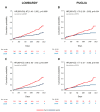When Real-World Outcomes Do Not Meet the Results of Clinical Trials: Transfemoral Transcatheter vs. Surgical Aortic Valve Replacement in an Intermediate-Age Population (The Outstanding Italy Study)
- PMID: 40429465
- PMCID: PMC12539603
- DOI: 10.3390/jcm14103471
When Real-World Outcomes Do Not Meet the Results of Clinical Trials: Transfemoral Transcatheter vs. Surgical Aortic Valve Replacement in an Intermediate-Age Population (The Outstanding Italy Study)
Abstract
Objective: Aortic valve stenosis is the most common valvular heart disease in the elderly, and its treatment may be either surgical (SAVR) or transcatheter (TAVI). Although age is one of the main determinants of the therapeutic choice, current guidelines leave a "discrepancy area" between 65 and 75 years, with the American guidelines allowing TAVI for patients older than 65 years, while the European guidelines consider TAVI for patients older than 75 years. The present study addresses the outcomes of SAVR vs. TAVI in a real-world population aged 65 to 80 years, that is, one largely inclusive of the discrepancy area. Methods: This is a retrospective registry study based on data retrieved from administrative health databases of two large Italian regions (Lombardy and Puglia). Patients aged 65 to 80 years receiving either SAVR or a TAVI between 2018 and 2021 were selected. SAVR and TAVI outcomes (death, cardiac and non-cardiac events) were compared using a propensity-matching analysis, with a follow-up of 2 to 5 years and mortality as the primary outcome. Results: After propensity matching, two groups of 786 patients were compared in Lombardy and two groups of 321 patients were compared in Puglia. In both regions, at the end of follow-up, mortality was significantly (p < 0.001) lower in SAVR vs. TAVI (24.6% vs. 47.2% in Lombardy and 18.1% vs. 44.1% in Puglia). Conclusions: Our results are in contrast with the randomized controlled trials showing equivalence or even the superiority of TAVI vs. SAVR, but in agreement with other registry studies based on real-world data. With respect to the randomized controlled trials, the main difference is a better outcome in SAVR. Caution should be applied in addressing patients < 80 years with TAVI unless SAVR is contraindicated.
Keywords: aortic valve stenosis; outcome; surgical aortic valve replacement; transcatheter aortic valve implantation.
Conflict of interest statement
The authors declare no conflict of interest.
Figures


References
-
- Osnabrugge R.L., Mylotte D., Head S.J., Van Mieghem N.M., Nkomo V.T., LeReun C.M., Bogers A.J., Piazza N., Kappetein A.P. Aortic stenosis in the elderly: Disease prevalence and number of candidates for transcatheter aortic valve replacement: A meta-analysis and modeling study. J. Am. Coll. Cardiol. 2013;62:1002–1012. doi: 10.1016/j.jacc.2013.05.015. - DOI - PubMed
-
- Otto C.M., Nishimura R.A., Bonow R.O., Carabello B.A., Erwin J.P., 3rd, Gentile F., Jneid H., Krieger E.V., Mack M., McLeod C., et al. 2020 ACC/AHA Guideline for the Management of Patients With Valvular Heart Disease: Executive Summary: A Report of the American College of Cardiology/American Heart Association Joint Committee on Clinical Practice Guidelines. J. Am. Coll. Cardiol. 2021;77:450–500. doi: 10.1016/j.jacc.2020.11.035. - DOI - PubMed
-
- Coisne A., Lancellotti P., Habib G., Garbi M., Dahl J.S., Barbanti M., Vannan M.A., Vassiliou V.S., Dudek D., Chioncel O., et al. ACC/AHA and ESC/EACTS Guidelines for the Management of Valvular Heart Diseases: JACC Guideline Comparison. J. Am. Coll. Cardiol. 2023;82:721–734. doi: 10.1016/j.jacc.2023.05.061. - DOI - PubMed
Grants and funding
LinkOut - more resources
Full Text Sources
Medical

